Julie Boatman Filucci's Blog, page 3
October 20, 2024
What Moose Means to Me
The opportunity to finish what we started—and witness the power of nature’s hand in forest renewal—compelled me to return to 1U1.
Stories have led me to enchanting places, but few resonate deep within me like the Idaho backcountry.
Our commitment to the Recreational Aviation Foundation and its mission to preserve access to wild, wonderful airstrips we treasure led us to return to Moose Creek USFS (1U1) in the Selway Bitterroot Wilderness in early October by Daher Kodiak 100. This time around, having the freedom to share my personal connection to the mission is a gift—pure gold like the aspens turning and shivering in the breeze. We flew in on a Friday, with plans to work through the weekend, rebuilding fence and joining fellow pilots and enthusiasts in the camaraderie such effort engenders.
 Moose Creek Airstrip approaching from the northeast. [Credit: Julie Boatman]
Moose Creek Airstrip approaching from the northeast. [Credit: Julie Boatman]
 The flight deck of Daher Kodiak N504KQ. [Credit: Julie Boatman]
The flight deck of Daher Kodiak N504KQ. [Credit: Julie Boatman]
 Volunteer pilots Bob Miller and Bob Wells dropped us off, along with RAF staff Carmine and Kodi. [Credit: Stephen Yeates]
Volunteer pilots Bob Miller and Bob Wells dropped us off, along with RAF staff Carmine and Kodi. [Credit: Stephen Yeates]My 7-year-old self carried a little backpack on our family trip to Glacier National Park in the late 70s, just a short flight north of where we’re bunking down for the night. So it feels like returning home, snuggling into a sleeping bag in the loaner tent we put up hours before—at little or no risk to our marriage. It was perfectly chilly on Friday night, just below freezing but enough to keep my beanie on through ’til morning. From a tent at Oshkosh this year to this place… two of the happiest places on earth to me. But in honesty, the more perfect one is this, miles and miles from any road. The silence of the pillaring pines covers us like a blanket until the wind filters through them. So many snapped off at the shoulders from a violent yet brief windstorm, a microburst that hit on July 25 after the Moose Creek Complex fires of ’24 raged through, led by the Wye Fire in late July.
The Moose we knew last October—when we put up the first tranche of fence—has been left shaken by the impact but repairable by both human and invisible hands. Power tools had been called in to assist: The special dispensation to use chainsaws to break down the massive trunks left akimbo after the storms speaks to the size of that task. To do so with the hand saws normally allowed by the Wilderness Act would take years.

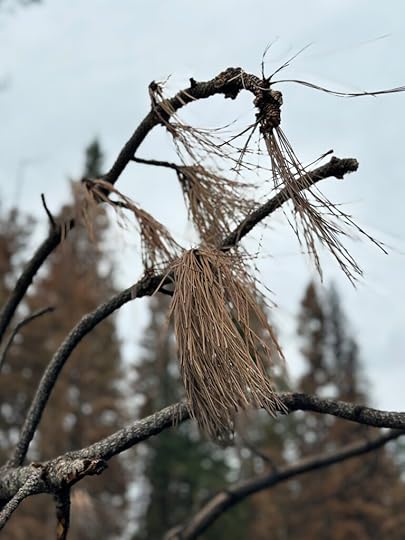

The forest will regenerate on its own terms and timeline. It always does. It needs the fire and the wind and the deep snows to renew itself.
We flew in Daher’s serial number one Kodiak last year—the same one that made the model’s first flight 20 years ago—on October 16, 2004, and not far from this place. That was N490KQ, which continues to fly under experimental status. It’s in flight test on Aerocet floats at the time of this writing, in fact. This year we met Bob Miller at KMSO in N504KQ, another Daher-donated critical airlift provider. The short flight over bumped us around a fair bit at 8,500…but as promised after we descended below the ridgelines it smoothed out completely. The winds aloft hadn’t made it down yet, thankfully. However, a front would power through later that evening, raining on us briefly with a twist of wind swirling around the treetops. Fred the cook accelerated our dinner plans so we didn’t get caught out.
 Telling tales around a campfire is one of the top reasons why we gather in these places. [Credit: Julie Boatman]
Telling tales around a campfire is one of the top reasons why we gather in these places. [Credit: Julie Boatman]
 The firemaster at the Solo stove enjoys his job. [Credit: Julie Boatman]
The firemaster at the Solo stove enjoys his job. [Credit: Julie Boatman]
 Kodiak pointing down Runway 22 at Moose Creek. [Credit: Julie Boatman]
Kodiak pointing down Runway 22 at Moose Creek. [Credit: Julie Boatman]The campfire around Bill’s Solo stove waited ’til Saturday night, which stayed calm and cool with a billion stars above us streaking across the Milky Way. By that time, we’d completed the rest of the fence surrounding the pasture—courtesy of another load brought in by Kodiak in the clutch. We were short 36 cross-bucks in the original materials flown and hauled in earlier, so the turboprop-that-could was dispatched to Missoula Saturday morning to pick up more.
 After delivering the needed cross-bucks, the Kodiak is unloaded by RAF volunteers. [Credit: Julie Boatman]
After delivering the needed cross-bucks, the Kodiak is unloaded by RAF volunteers. [Credit: Julie Boatman]
 Unloading a cross-buck is easily done out of the Kodiak’s ample rear door. It’s like it was made for this… [Credit: Julie Boatman]
Unloading a cross-buck is easily done out of the Kodiak’s ample rear door. It’s like it was made for this… [Credit: Julie Boatman]The infusion of lumber meant the world to us on the work crew—to leave the fence just a dozen yards short would have triggered compulsive feelings of incompletion for an agonizingly long time. And it meant a lot to the agencies participating in this particular project—the U.S. Forest Service, certainly, but also the Montana Conservation Corps and the Selway Bitterroot Frank Church Foundation (SBFC).
Two outhouses also burned in the August blaze… so the materials brought in included a pair of IKEA-style latrine kits—and Craig, who was the expert on putting them together. Within a day, we had two fully functional outhouses painted in Oxford Brown down at the southern end of the runways, in the “triangle.”
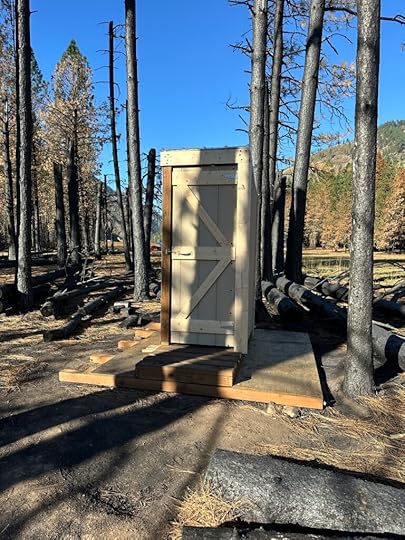 Two new outhouses replaced the ones burned in the fires at Moose Creek in 2024. [Credit: Julie Boatman]
Two new outhouses replaced the ones burned in the fires at Moose Creek in 2024. [Credit: Julie Boatman]
 The damage from the fires over the summer of 2024 was extensive around the airstrip at Moose Creek. [Credit: Julie Boatman]
The damage from the fires over the summer of 2024 was extensive around the airstrip at Moose Creek. [Credit: Julie Boatman]
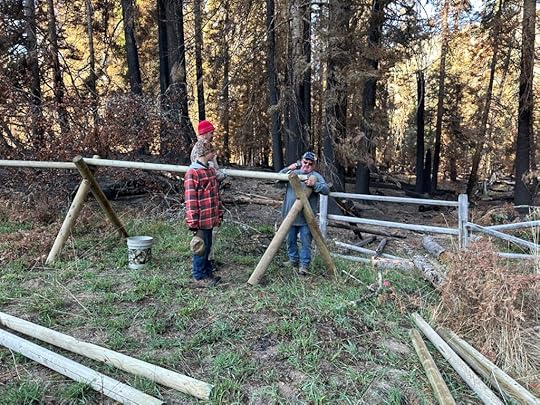 The Recreational Aviation Foundation work parties take on many casts, but this one was all about building fence. [Credit: Julie Boatman]
The Recreational Aviation Foundation work parties take on many casts, but this one was all about building fence. [Credit: Julie Boatman]Our meals shared around the picnic tables in front of the cookhouse expanded to fit the ~60 folks who showed up in more than 40 airplanes. Mealtime also gave us two special canine companions, Roux and Tate, who followed the enticing aromas of barbecue over from an outfitter’s campsite on the north edge of the complex.
No one could know how my heart clenched in a fist as Tate cautiously came up under my hand for a scratch behind his ears and a bid for food—he looked so much like Eddy, the pup we lost tragically to an accident in May, who possessed similarly soulful eyes. Every nibble of pulled pork, every flipped potato chip—he caught them along with the spirit of the crazy sweet dog we miss every day. Throughout this past sorrowful summer, hikes on the Appalachian Trail and marathon training runs had worked to heal my heart somewhat…but I really needed the mountains to swallow up the gaping hollowness inside me. I got my mountains twice this season—Colorado at the end of August, and the October week in Montana and Idaho. The honest work, lifting logs to my shoulders to portage like a canoe, back and forth, powered by Trish McKenna’s cookies, begun healing me in other places as well. Grief isn’t linear; it comes in waves. Tears mix well with sweat; they have a similar saline composition.
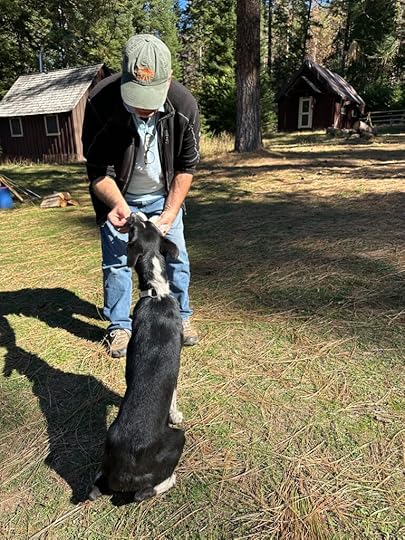 Stephen gives a treat to Tate, one of the camp canines of the trip, and dear to us. [Credit: Julie Boatman]
Stephen gives a treat to Tate, one of the camp canines of the trip, and dear to us. [Credit: Julie Boatman]
 A sign singed by fire stands sentinel along the trail to the confluence of the Selway and Moose Creek. [Credit: Julie Boatman]
A sign singed by fire stands sentinel along the trail to the confluence of the Selway and Moose Creek. [Credit: Julie Boatman]
 We gathered for meals in front of the cook house three times a day. [Credit: Julie Boatman]
We gathered for meals in front of the cook house three times a day. [Credit: Julie Boatman]Speaking of flowing water, Stephen and I hiked down to the confluence of the Selway and Moose Creek on Sunday morning, to witness more of the fire’s effect and record in photos this passing of time and memory. Any time we can scramble around rocks, we’re content, and the rounded river pebbles we felt under our feet will outlast us all.
The RAF crew finished this project ahead of schedule—many hands making light work indeed—and so we flew out a day earlier than planned. Bob Wells came to fetch us, again in N504KQ, and though we didn’t have the Missoula Tower making mother-in-law jokes on that segment, the flight was seasoned with the smoke from the Sheridan Fire blowing up from Wyoming.
As the last of the leaves fall, I know someday we’ll return to 1U1, though other projects and other places beckon. But there’s a bond I feel with “Moose” that will go on as long as I do.

The post What Moose Means to Me appeared first on JulietBravoFox Media.
September 27, 2024
Seeing the Future on the PCH
Driving back from the Santa Monica Airport to my friend’s house in Agoura Hills, I have the option of going the coastal route, skipping the 101 and its traffic vagaries and headaches.
The Pacific Coast Highway up to Malibu, with a turnoff right at Pepperdine (Waves!!) snuggles me in like a old pair of yoga pants as I join the parade past the beaches to the left and the Palisades rising to the right.
Just past the turnoff to the Bay Inn, a motion above the water ahead catches my eye. I think it’s a helicopter at first—those fly by regularly on this stretch of SoCal—but I register with a start it’s the Joby test article, N54LAX, that had been on display all day at KSMO, in honor of Donald Douglas Day.
 Screenshot
ScreenshotI had just witnessed a milestone in history. And I saw our future.
In a conversation with Joby founder JoeBen Bevirt last year, his tone and his passion as he related his desire to innovate point-to-point transport into a whisper-quiet, zero-emissions occurrence touched me. It came back in waves—yes—as I slowed and stopped at the next light, considering my trip up the coast versus the joyful flight those members of the Joby team would enjoy on their sightseeing cruise. While the 228-nm flight all the way to Marina wasn’t in the cards—but could it be, at this moment in time, completed directly by airplane or helicopter—or eVTOL? In near silence, at dollars per hour instead of thousands?
Well, here we are. That future is imminent.
What a fitting close to Donald Douglas Day, celebrating a man who brought commercial air transport to the masses with the Douglas DC-3, nearly 90 years ago.
He would have *loved* the Joby, Archer, Pivotal, Pipistrel, and Airhart displays at Santa Monica on “his” day.
The post Seeing the Future on the PCH appeared first on JulietBravoFox Media.
September 19, 2024
Santa Monica to Celebrate Donald Douglas Day
It seems a bit far-fetched, that a municipality so dead-set on closing its aviation jewel
—the Santa Monica Airport (KSMO)—would set aside a day to celebrate the man who put the town on the map, as far as the aerospace industry is concerned.
Yet on Sunday, September 22, Santa Monica will recognize Donald Douglas Day with a grand affair at the airport, marking the week 100 years ago when the Douglas World Cruisers returned to California following their epic round-the-world flight.
I plan to be on hand all day, working with Pilot Outfitters and the Santa Monica Flyers to promote the history of Douglas Aircraft Company, and the innovation that Douglas not only inspired but invested in and propelled forward.
Come join me! I will be signing my books, Honest Vision: The Donald Douglas Story, and Together We Fly: Voices From the DC-3, and talking with folks about the legendary DWCs and DC-3s that were built at Clover Field. Bring your copy or pick one up from Pilot Outfitters for me to sign. I look forward to meeting everyone!

The post Santa Monica to Celebrate Donald Douglas Day appeared first on JulietBravoFox Media.
September 11, 2024
Remembering 9/11
On that Tuesday 23 years ago we will never forget, I sat in my office at the Aircraft Owners & Pilots Association, getting started on the morning’s editing or writing or… I don’t recall anymore.
Because around 9 am, Miriam, our executive admin, popped into the doorway and said that an airplane had just struck the World Trade Center.
What unfolded thereafter, I have shared in several pieces over the years, but the memory never loses its power. It was perhaps my first experience with the world completely turning on a dime. There was before… and after. And only that moment in between.
We will always remember the attacks of September 11, when we lost airline crews and passengers, Pentagon workers, first responders, and people just going about their day in downtown Manhattan.
For the first time I’m collecting those stories in one place, so that others can share them. And never forget.
September 9, 2024
One Hundred Years Ago: A Crossing
At the same time that the newly christened Douglas DC-3, Spirit of Douglas, made its way from Caen, France to North Weald, England, to Wick, Scotland, to Reykjavik, Iceland, to Narsarsuaq, Greenland, to Goose Bay, Labrador, to Burlington, Vermont—we also collectively celebrated the 100 years since the Douglas World Cruisers—the three left, Boston, Chicago, Seattle—plied a similar path across the North Atlantic.
Except, in 1924, no one else had done it.
 The route the Douglas World Cruisers took across the North Atlantic mimics the one flown by many single- and twin-engine airplanes today, including the Douglas DC-3 “Spirit of Douglas” on its latest crossing. [Courtesy of @firstworldflightcentennial]
The route the Douglas World Cruisers took across the North Atlantic mimics the one flown by many single- and twin-engine airplanes today, including the Douglas DC-3 “Spirit of Douglas” on its latest crossing. [Courtesy of @firstworldflightcentennial]
 The Chicago, Boston, and Seattle had made it thus far on the round-the-world journey. [Courtesy of @firstworldflightcentennial]
The Chicago, Boston, and Seattle had made it thus far on the round-the-world journey. [Courtesy of @firstworldflightcentennial]
 The Douglas World Cruisers reached Mere Point, Maine, first. [Courtesy of @firstworldflightcentennial / Pejebscot History Center]
The Douglas World Cruisers reached Mere Point, Maine, first. [Courtesy of @firstworldflightcentennial / Pejebscot History Center]One hundred years ago this Labor Day Weekend, New Yorkers lined the harbor to see the DWCs pass by, nearing the home stretch on their globe-cinching adventure.
We also watched from our home base as Spirit of Douglas winged its way past us heading to its temporary home base, at Aerometal International, in Aurora, Oregon (KUAO). Many plans lay ahead for the newly restored flying tribute to Donald Douglas—and we’ve been invited to share stories along the way.
 The leg from Wick to Reykjavik crosses the first cold open water of the overall journey. [Courtesy of Flight Aware]
The leg from Wick to Reykjavik crosses the first cold open water of the overall journey. [Courtesy of Flight Aware]
 The straight line between points indicates periods between areas of radar coverage. [Courtesy of Flight Aware]
The straight line between points indicates periods between areas of radar coverage. [Courtesy of Flight Aware]For the moment, we’re counting down to September 22, when we’ll spend Donald Douglas Day at the Santa Monica Airport (KSMO). The last legs of the DWC adventure have further hazards to surmount for the crews, as it turns out.
 The “Spirit of Douglas” sports the rondel honoring the “First Around the World” achievement of the Douglas World Cruisers. [Credit: Julie Boatman]
The “Spirit of Douglas” sports the rondel honoring the “First Around the World” achievement of the Douglas World Cruisers. [Credit: Julie Boatman]
August 2, 2024
EAGLE Rides a Bit of Turbulence at Oshkosh
While a record number of folks flew in to Oshkosh, the forum wasn’t quite full for the EAGLE (Eliminate Aviation Gas Lead Emissions) briefing at 10 am on Monday, July 22. But a couple hundred interested parties (pilots) did show up—and they were in for quite a review, punctuated by events unfolding throughout the week at EAA AirVenture. To review, EAGLE’s goal is to eliminate the use of leaded fuels in piston-powered aircraft in the U.S. by the end of 2030.
In the briefing, the FAA and industry consortium put representatives up on the forum stage, including co-chairs Curt Castagna, of the National Air Transportation Association (NATA), and Wes Mooty, acting administrator on certification for the FAA. William Desrochiers, GAMA’s technical lead on fuels, presented as well.
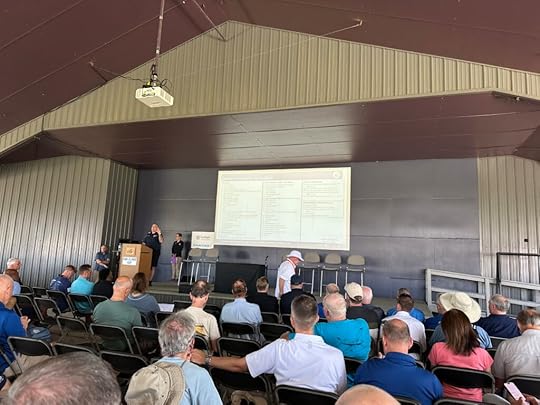 William Desrochiers of GAMA presents on the long list of required materials testing in the path to approval for a fuel. [Credit: Julie Boatman]
William Desrochiers of GAMA presents on the long list of required materials testing in the path to approval for a fuel. [Credit: Julie Boatman]Desrochiers gave an in-depth look at where each of the candidate fuels are on the path to the marketplace. But even the “big picture” simplified version of that path appeared more complex than has been perhaps sold to constituents.
Three candidate fuels remain in the mix:
* GAMI’s G100UL, which has an STC but no ASTM specification acceptance
* Swift’s UL100R, which is undergoing concurrent STC and ASTM compliance testing
* LyondellBasel Industries’ UL100E, going through the Piston Engine Aviation Fuels Initiative (PAFI) program, which progresses towards ASTM acceptance and fleet authorization
After compliance is unlocked, the stakeholders in the supply chain must accept it along the way: aircraft and engine OEMs, fuel distributors, FBOs, aircraft owners/operators, and pilots.
Dan Pourreau, of LyondellBasel Industries, maker of UL100E currently going through the PAFI process, led a separate presentation later in the week. In it, he noted that a true drop-in replacement for 100LL was quickly passing from reality. One reason? The MON (mean octane number) of 100LL with which many high-compression engines were certificated is roughly 104, and may be as high as 106.
The best that unleaded fuel can do with non-lead boosters has been around 100 MON. That means that if an engine cannot accept the 100 MON, it may need mods to its operating conditions, such as cylinder head temperature limitations (“paper mods”), or further mechanical or technical mods.
Materials Testing?There’s another concern raising a specter over the viability of GAMI’s fuel in particular. And that has to do with the materials testing that earlier candidate fuels in the PAFI program failed to pass. When you put fuel into the wing of an airplane, you pump it into a tank and start its journey through a system that includes elastomers (O-rings, hoses), metals, rubbers and other bladder materials, plastics, sealants, and paint. You have the certified fleet to consider when walking through the potential interactions—and then there’s the experimental fleet.
During Desrochiers’ presentation, he popped up a Materials Compatibility Testing Matrix slide listing an outline of the materials that EAA has put forward through the EAGLE consortium for consideration in the process of ensuring a candidate fuel won’t negatively interact with anything it comes into regular contact with. While the OEM holds responsibility for testing certified aircraft (including its legacy models), the individual builder must test their own.
So, one of the 2,846 showplanes on EAA’s display last week drew my interest as a result of this question: the Beechcraft Baron that the Aircraft Owners and Pilots Association (AOPA) is using to demonstrate to its members the high-octane unleaded fuels vying to replace 100LL. I’d have reason to take a close look at it as the week wore on—Oshkosh often serves as a proving ground for new designs and technologies, in that they must sit out in the sun, wind, and storms for more than a week in many cases. That’ll test anyone’s material makeup.
AOPA flew the Baron to the show with GAMI’s fuel powering the left engine. As the week wore on, two things raised questions in the area of materials compatibility—though nothing is conclusive yet. The first one feels perhaps cosmetic: the stain growing on and around the fuel cap on the left main tank where white paint had been previously.
 The fuel cap on the left main tank of the Baron flown by AOPA for unleaded fuels testing. [Credit: Julie Boatman]
The fuel cap on the left main tank of the Baron flown by AOPA for unleaded fuels testing. [Credit: Julie Boatman]
 Sludge weeping from seams under the wing of the Baron at the AOPA exhibit. [Credit: Julie Boatman]
Sludge weeping from seams under the wing of the Baron at the AOPA exhibit. [Credit: Julie Boatman]
 Reaching a low point in the wing, perhaps, the substance had the appearance of oil but smelled more of sealant. [Credit: Julie Boatman]
Reaching a low point in the wing, perhaps, the substance had the appearance of oil but smelled more of sealant. [Credit: Julie Boatman]The second one feels more onerous, though we don’t yet know what the cause is. A line of oil-colored sludge reeking vaguely of sealant seeped from the seams underneath the wing, at low points near where the tank sits inside the wing. I crawled under to take a look myself, and it was there for all to see. Until the source of the sludge is inspected, however, its origin is inconclusive. Stay tuned for more as other results of long-term testing/demonstrations come to light.
We Have a Mixing ProblemThe FAA recently published data that indicates GAMI’s fuel uses m-toluidine, an aromatic amine, as an octane booster. Not only does this set of chemicals potentially pose materials compatibility problems, but it also raise the problem of intermixing in the field—or within a tank. For its part, Swift Fuels has stated that any fuels containing aromatic amines cannot be intermixed with any Swift Fuel, including the UL100R.
LyondellBasel reported that its fuel will be fully miscible with 100LL, since it runs very close to the leaded fuel in its chemical and physical properties. But it too is not likely to be mixable with either GAMI’s or Swift’s fuels.
And that prompted me to ask the question at the forum, is there a point at which the FAA and industry will need to get behind one fuel to move forward with—especially since FBOs are unlikely to have multiple tanks to dedicate to unleaded fuels? The market is so small as it is, and the risk of bifurcating it into two or three high octane unleaded fuels doesn’t sit well.
With these clouds on the horizon, the race to field a workable unleaded fuel solution for the GA fleet by 2030 has only intensified. The next EAGLE report will be virtual, in October. I plan to be there—will you?
July 26, 2024
Oshkosh 2024: Day Four Training
Lots of pilots come to EAA AirVenture each year to learn, whether it’s in a builder’s forum, an expert panel, or a session in a flight sim at the Pilot Proficiency Center.
Thursday held a training theme for me around master instructors, with three gatherings tuned to bring CFIs together.
The first was the annual member breakfast for the National Association of Flight Instructors (NAFI). During the event, NAFI inducted Doug Stewart and Tim Tucker into the Instructor Hall of Fame, and gave the Eggespuehler and Laslo awards to Samantha Bowyer and author Steve Rutland.
The second was the annual King Schools press conference and lunch, which gathered flight school leaders and scholarship winners along with John and Martha King—legendary instructors who take the time to talk with everyone who comes their way.
Third was the dinner hosted by the Society of Aviation and Flight Educators (SAFE), during which Instructor Hall of Fame member Rich Stowell gave his presentation on 9 Principles of Light Aircraft Flying.
At each event, I took away something I intend to apply to my own dual given.
 The 2024 inductees to the National Instructor Hall of Fame were honored at NAFI’s breakfast. [Credit: Julie Boatman]
The 2024 inductees to the National Instructor Hall of Fame were honored at NAFI’s breakfast. [Credit: Julie Boatman]
 John and Martha King pose for their raving fans at their lunch press conference. [Credit: Julie Boatman]
John and Martha King pose for their raving fans at their lunch press conference. [Credit: Julie Boatman]
 David St. George kicks off the annual SAFE dinner on Thursday evening. [Credit: Julie Boatman]
David St. George kicks off the annual SAFE dinner on Thursday evening. [Credit: Julie Boatman]
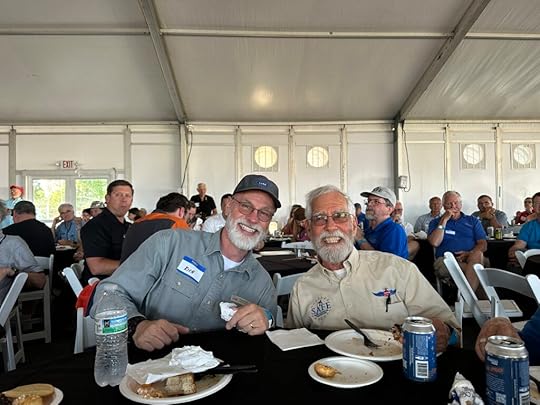 Rich Stowell and Doug Stewart catch up at the 2024 SAFE dinner at Oshkosh 2024. [Credit: Julie Boatman]
Rich Stowell and Doug Stewart catch up at the 2024 SAFE dinner at Oshkosh 2024. [Credit: Julie Boatman]
July 25, 2024
Oshkosh 2024: Day Three Tech
For an Oshkosh lacking major announcements—no totally new aircraft, no killer app—the quiet part out loud could be found in applications of new technology to familiar aircraft.
The headliner has to be the Harbour Air eBeaver, tucked into the main aircraft display, featuring a Magni650 power train. We spoke with Riona Armesmith, CTO of MagniX, and she briefed us on the operation of the dual motor, four inverter system driving a Hartzell composite prop. The STC is in work while flight tests comtinue.
The next pair involve simplified flight controls. We signed up for a demo of the Skyryse system in the sim set up in the shadow of the tower. We’re under NDA, but if the four-axis controls work as advertised, in a Robinson R66, we’ll likely need a different pilot certificate for traditional rotorcraft—worse than giving a manual transmission car to a kid who has only driven an automatic.
We also met up with Airhart’s founder and CEO Nikita Ermoshkin, who we interviewed for a story on Robb Report last week. The team is testing simplified flight controls in a Sling E-LSA, after flying its first proof-of-concept in an RV-12. The idea? Bringing easy flight to the masses. And I say making it possible to get a sport pilot certificate in 20 hours or less—for real.
July 24, 2024
Oshkosh 2024: Day Two Communities
With the relaunch of JulietBravoFox Media, we’ve captured back a bit more time to volunteer with the aviation missions closest to our hearts. Day Two at AirVenture was filled with meet-ups for two key groups: the Recreational Aviation Foundation and LightHawk.
We kicked off the day with doughnuts and coffee and good times with our fellow RAF volunteers on the top of the Hartzell booth, with a great view of the main aircraft display. Pete Bunce of GAMA honored a couple of special contributors, and then we went on a walk to take photos of the orange RAF gaggle at sponsors’ exhibits around the show: Redbird Flight Simulations, Daher, and Aviat.
Next, we had a gathering of LightHawk volunteer pilots, of which Julie just became one—along with the contribution of Stephen’s photography. We met at the Textron Aviation booth, hosted by board chairman Steve Kent. We shared our latest missions and took a tour of the Cessna, Beech, and Pipistrel aircraft on display.
Our evening capped off with two parties celebrating community: AOPA’s 85th anniversary bash at The Waters, and the Pilatus/Piper Block Party, where we met up with old friends.
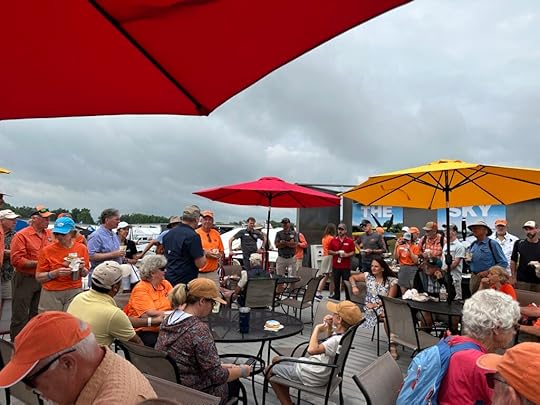 Doughnuts and coffee and camaraderie celebrate the Hartzell rooftop gathering of volunteers with the Recreational Aviation Foundation. [Credit: Julie Boatman]
Doughnuts and coffee and camaraderie celebrate the Hartzell rooftop gathering of volunteers with the Recreational Aviation Foundation. [Credit: Julie Boatman]
 Stephen and Julie met up with fellow LightHawk volunteer pilots at the Textron Aviation exhibit, sharing stories with friends old and new. [Credit: Julie Boatman]
Stephen and Julie met up with fellow LightHawk volunteer pilots at the Textron Aviation exhibit, sharing stories with friends old and new. [Credit: Julie Boatman]
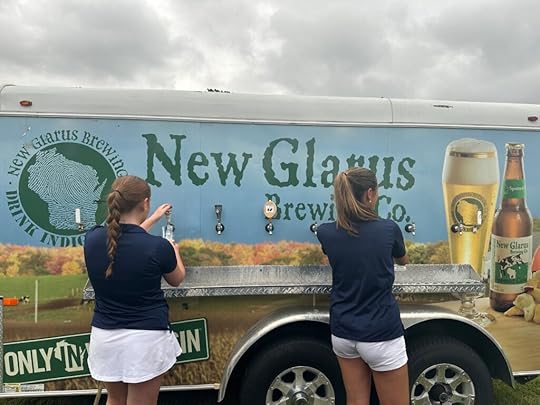 AOPA brough New Glarus on tap for its 85th anniversary party at the Waters. [Credit: Julie Boatman]
AOPA brough New Glarus on tap for its 85th anniversary party at the Waters. [Credit: Julie Boatman]
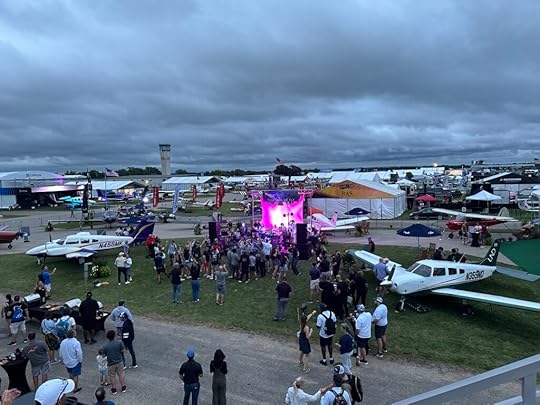 Pilatus and Piper hosted their annual “block party” showing that even competitors find community at Oshkosh. [Credit: Julie Boatman]
Pilatus and Piper hosted their annual “block party” showing that even competitors find community at Oshkosh. [Credit: Julie Boatman]
July 23, 2024
Oshkosh 2024: Day One Takes
This year’s EAA AirVenture launched with a relentless lineup of press conferences and events impossible for one person to cover—so it’s great to have a team here!
We started off with the Cirrus presser and Todd Simmons gave his characteristically enthusiastic run down of the company’s recent success—and the 10,000th SR and 500th Vision Jet are on display here at the show.
Daher’s Nicolas Chabbert introduced the Multi-Mission Kodiak 900 with its truly dynamic paint scheme to show off the company’s new paint facility in Sandpoint. Chabbert gave the mike to CEO and group chair Didier Kayat for his update, then introduced the interns for 2024—one from the US, one from Canada, and two from France.
The EAGLE initiative delivered a detailed update—and raised a lot of questions. More on this in an in depth edition of #JustJuliesTakes later this week.
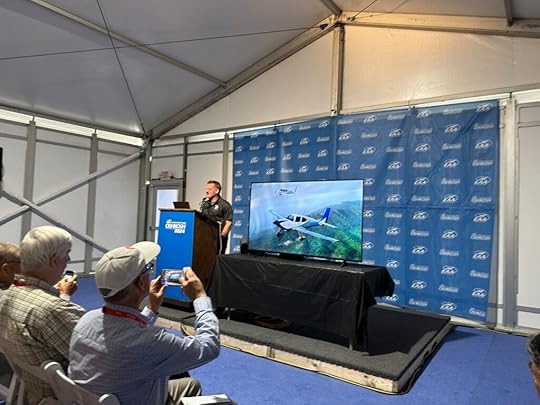 Todd Simmons heads up the customer experience team at Cirrus. [Credit: Julie Boatman]
Todd Simmons heads up the customer experience team at Cirrus. [Credit: Julie Boatman]
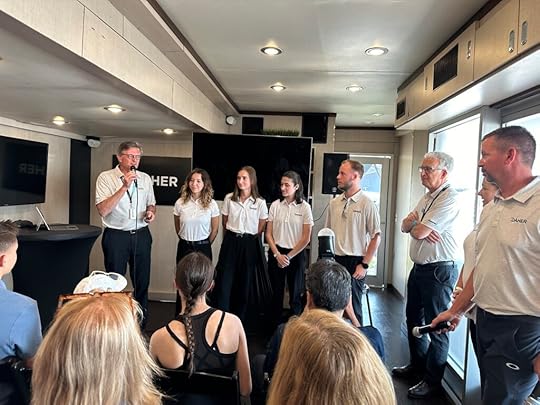 Nicolas Chabbert, CEO of Daher’s Aircraft Division, introduces the 2024 interns in the company’s program with GAMA. [Credit: Julie Boatman]
Nicolas Chabbert, CEO of Daher’s Aircraft Division, introduces the 2024 interns in the company’s program with GAMA. [Credit: Julie Boatman]
 The EAGLE update on unleaded fuel for GA sparked a lot of questions from the crowd. [Credit: Julie Boatman]
The EAGLE update on unleaded fuel for GA sparked a lot of questions from the crowd. [Credit: Julie Boatman]
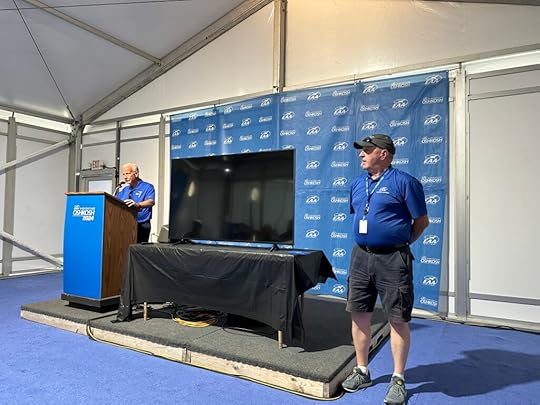 EAA Chairman and CEO Jack Pelton and Director of Coms Dick Knapinski kick off AirVenture with a big lineup and lots of folks flying in. [Credit: Julie Boatman]
EAA Chairman and CEO Jack Pelton and Director of Coms Dick Knapinski kick off AirVenture with a big lineup and lots of folks flying in. [Credit: Julie Boatman]



